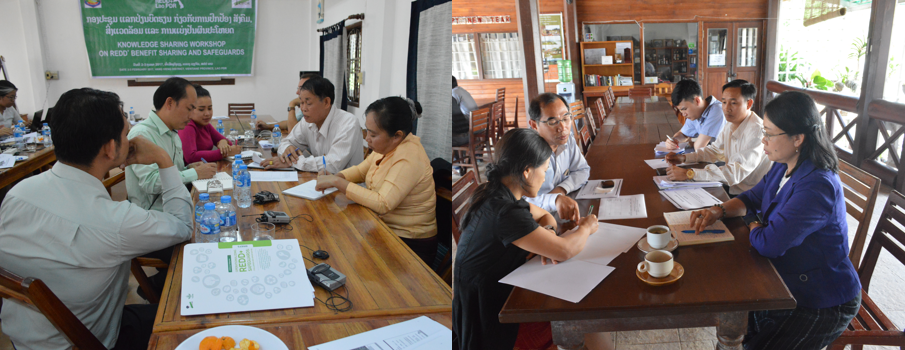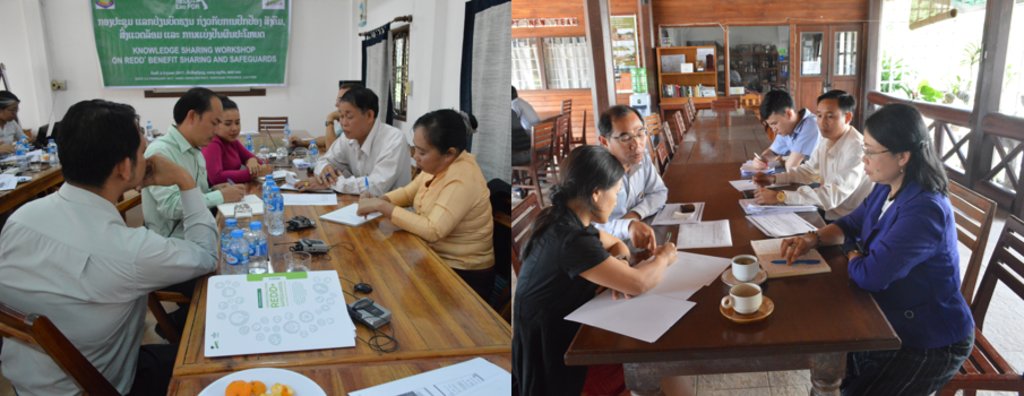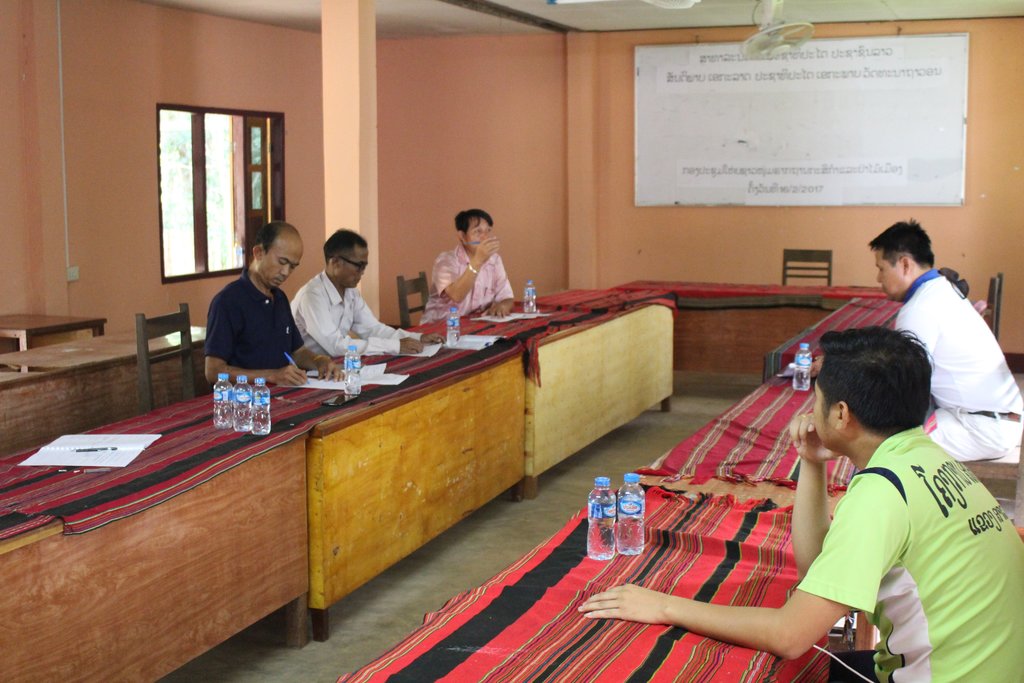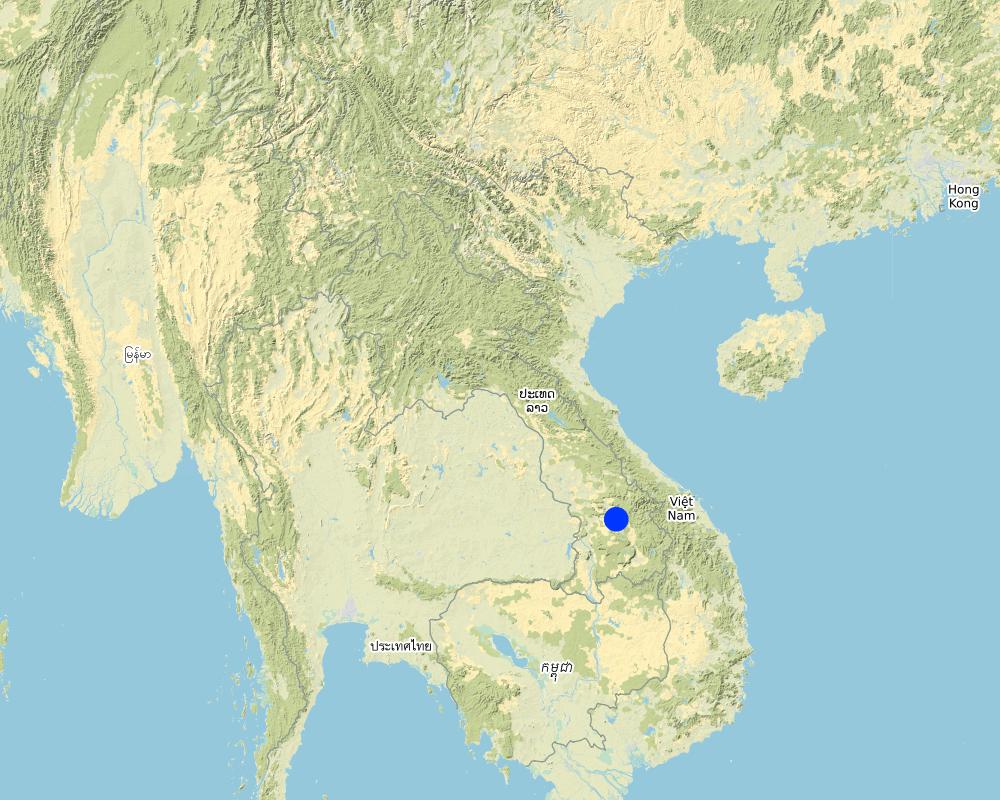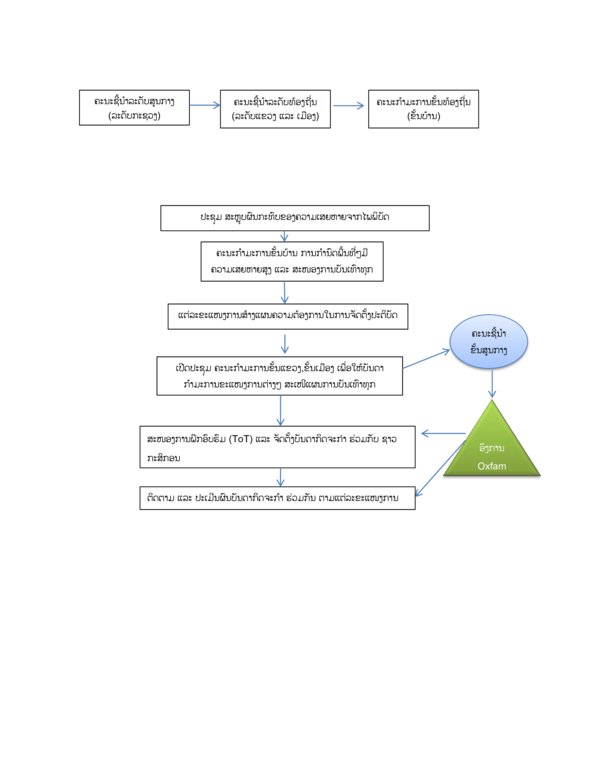The Upland Community Disaster Risk Reduction Project [老挝人民民主共和国]
- 创建:
- 更新:
- 编制者: Pasalath Khounsy
- 编辑者: Bounthanom Bouahom
- 审查者: Nicole Harari, William Critchley
approaches_3218 - 老挝人民民主共和国
查看章节
全部展开 全部收起1. 一般信息
1.2 参与方法评估和文件编制的资源人员和机构的联系方式
关键资源人员
土地使用者:
Malichanse Soukkaseum
smalychansy@gmail.com
Oxfam Australia in Saravan province
老挝人民民主共和国
District steering committee:
Vilaysak Seuth
Taouy District of Agriculture and Forestry Office
老挝人民民主共和国
District steering committee:
Keokhamma Boutsa
ໍ+8562099704868
TaOuy District Labour and Social Welfare Office
老挝人民民主共和国
有助于对方法进行记录/评估的项目名称(如相关)
Scaling-up SLM practices by smallholder farmers (IFAD)有助于对方法进行记录/评估的机构名称(如相关)
National Agriculture and Forestry Research Institute (NAFRI) - 老挝人民民主共和国1.3 关于使用通过WOCAT记录的数据的条件
(现场)数据是什么时候汇编的?:
31/08/2017
编制者和关键资源人员接受有关使用通过WOCAT记录数据的条件。:
是
2. SLM方法的描述
2.1 该方法的简要说明
The disaster risk reduction project in upland communities aims to increase understanding about disaster management, disaster risk reduction, and community resilience. The main activities include emergency response during floods/droughts, reduction of impacts from disease outbreaks, livestock revolving funds, and village rice banks.
2.2 该方法的详细说明
该方法的详细说明:
The disaster risk reduction project in upland communities was established after the Ketsana typhoon hit the southern region of Lao PDR in 2008, causing significant losses to assets, infrastructure, and agricultural land. The project was approved by the Ministry of Labour and Social Welfare, and Ministry of Planning and Investment to be implemented at community level through a project steering committee which included the deputy provincial governor. The district governor was the project director at the local level based on an action plan developed by the ministries concerned with assistance from Oxfam Australia. This action plan was aimed at disaster prevention and control. The project coordinators came from the relevant government agencies including the District Labour and Social Welfare Office, the District Agriculture and Forestry Office, the District Administration Office, the District Health Office, the District of Natural Resources and Environment Office, and mass organizations (Women’s Union, Youth Union, Trades Union, and Lao Front for National Construction). The key project aims are to increase understanding about disaster management, disaster risk reduction, and community resilience. The main activities to be implemented include emergency response during floods/droughts, reduction of impacts from disease outbreaks, livestock revolving funds, and village rice banks. In the agriculture sector, the project promotes integrated crop cultivation (maize, beans, lemons, etc), a particular rice planting method termed SRI (System of Rice Intensification), and household gardens. In addition, Oxfam Australia and the local government of Lao PDR in cooperation with Care International (Xekong Province), and the World Food Programme provided emergency response and relief, and sanitation. Although there are a number of organizations which have contributed to disaster risk reduction and emergency response, constraints remain such as the implementation of limited life projects, inadequate funding, and a lack of coordination in the province and districts.. Village Committees for Disaster Prevention and Control have been established with regular meetings and disaster awareness campaign activities implemented. The project outcomes demonstrated that the communities are satisfied with their active participation.
2.3 该方法的照片
2.5 采用该方法的国家/地区/地点
国家:
老挝人民民主共和国
区域/州/省:
Saravan province
有关地点的进一步说明:
Taouy district
Map
×2.6 该方法的开始和终止日期
注明开始年份:
2008
若不知道准确的年份,请注明该方法的大致开始日期。:
不到10年前(最近)
终止年份(若不再采用该方法):
2014
注释:
There have been two different phase of project implementation. The first phase was from 1999-2001 and the second phase was 2008-2014.
2.7 方法的类型
- 基于项目/方案
2.8 该方法的主要目的/目标
The objectives of the project are to increase understanding about disaster management, disaster risk reduction, and community development in disaster impacted areas.
2.9 推动或妨碍实施本办法所适用的技术的条件
社会/文化/宗教规范和价值观
- 启动
Gender aspect – the project changed immoral traditional and cultural beliefs of people by encouraging men to have more involvement in household activities with women.
- 阻碍
The two different farmer’s groups in the village do not want to work together - including on establishment of village rice banks and water borehole drilling.
财务资源和服务的可用性/可得性
- 启动
Provide greater opportunities to vulnerable households to participate in the project, encourage local communities to access finance and animals for their own operations.
机构设置
- 启动
Established the district and village committees levels in order to support the construction and administration work.
参与者的的协作/协调
- 启动
Regular collaboration with various levels including provincial, district and village.
法律框架(土地使用权、土地和水使用权)
- 启动
政策
- 启动
土地治理(决策、实施和执行)
- 启动
了解SLM,获得技术支持
- 启动
市场(购买投入,销售产品)和价格
- 启动
Set up the Chinese pear selling group
工作量、人力资源可用性
- 启动
3. 相关利益相关者的参与和角色
3.1 该方法涉及的利益相关者及其职责
- 当地土地使用者/当地社区
Farmer’s group
Implementer
- 社区组织
Village authorities and village organisation
Approve, certify and dissemination of key information
- SLM专家/农业顾问
District Agriculture and Forestry Office staffs
Supervise the project implementation and provide training
- NGO
Oxfam Project Staffs
Supervise the project implementation and provide training
- 地方政府
Provincial Agriculture and Forestry Office and District of Agriculture and Forestry Office staffs
Leading, monitoring the implementation of the project and provide training
- 国家政府(规划者、决策者)
Central Administrative Office in Vientiane and Ministries level.
Consultaition and approve the project implementation at national level.
- 国际组织
Oxfam International Office
Financial support
3.2 当地土地使用者/当地社区参与该方法的不同阶段
| 当地土地使用者/当地社区的参与 | 指定参与人员并描述活动 | |
|---|---|---|
| 启动/动机 | 互动 | |
| 计划 | 互动 | |
| 实施 | 互动 | |
| 监测/评估 | 互动 | |
| Field exchange | 互动 | Facilitate 20 staff and training on disaster management and 7 farmers from each village conducted the field exchange on rice production technologies. |
3.3 流程图(如可用)
3.4 有关SLM技术选择的决策
具体说明谁有权决定选择要实施的技术:
- 所有相关参与者,作为参与式方法的一部分
明确做出决策的依据:
- 对充分记录的SLM知识进行评估(基于证据的决策)
- 个人经验和意见(无记录)
4. 技术支持、能力建设和知识管理
4.1 能力建设/培训
是否为土地使用者/其他利益相关者提供培训?:
是
明确受训人员:
- 土地使用者
- 现场工作人员/顾问
培训形式:
- 在职
- 农民对农民
涵盖的主题:
The fund management, water supply uses, rice bank, veterinary, chicken raising, aquaculture, rice production, disaster risk preparedness and response, typhoon, forest fires, disaster warning equipment.
4.2 咨询服务
土地使用者有权使用咨询服务吗?:
是
指明是否提供了咨询服务:
- 在土地使用者的土地上
说明/注释:
Once per month
4.3 机构强化(组织发展)
是否通过这种方法建立或加强了机构?:
- 是,适度
具体说明机构的强化或建立程度:
- 本地
说明机构、角色和职责、成员等。:
The district and village committees for disaster prevention and control are responsible for supervising, acting as focal points and reporting to the provincial and central levels.
具体说明支持类型:
- 财务
- 能力建设/培训
- 设备
4.4 监测和评估
监测和评估是该方法的一部分吗?:
是
注释:
The M&E team of the Oxfam project organized a monthly monitoring meeting involving collaboration with the community board at village and district levels.
若是,该文件是否用于监测和评估?:
是
4.5 研究
研究是该方法的一部分吗?
是
明确话题:
- 技术
提供进一步的细节,并指出是谁做的研究:
A number of potentially appropriate activities have been modified to fit local conditions, such as: promotion economics / marketing of animal breeds that people never raised before.
5. 融资和外部物质支持
5.1 该方法中SLM组成部分的年度预算
说明该方法中SLM部分的年度预算,单位为美元:
100000.00
如果不知道准确的年度预算,请给出一个范围:
- 10,000-100,000
注释(例如主要的资助来源/主要捐助者):
AUSAid funding source
5.2 为土地使用者提供财政/物质支援
土地使用者是否获得实施该技术的财政/物质支持?:
是
如果是,请具体说明支持的类型、条件和提供者:
Financial supported by AUSAid and implemented by Oxfam Australia
5.3 对特定投入的补贴(包括劳动力)
- 劳动力
| 程度如何 | 对补贴做出具体说明 |
|---|---|
| 充分融资 | local communities supplied labor and the project paid for this |
- 建筑
| 具体说明哪些投入得到了补贴 | 程度如何 | 对补贴做出具体说明 |
|---|---|---|
| 石料 | 充分融资 | |
| 木材 | 部分融资 | Villagers |
- 基建
| 具体说明哪些投入得到了补贴 | 程度如何 | 对补贴做出具体说明 |
|---|---|---|
| 道路 | 充分融资 | Project |
| 学校 | 充分融资 | Project |
如果土地使用者的劳动力是一项重要的投入,那么是不是:
- 以粮换工
5.4 信用
是否根据SLM活动的方法给予信用值?:
否
5.5 其它激励或手段
是否有其他激励措施或工具用于促进SLM技术的实施?:
否
6. 影响分析和结论性陈述
6.1 方法的影响
该方法是否有助于当地土地使用者,提高利益相关者的参与度?:
- 否
- 是,很少
- 是,中等
- 是,支持力度很大
这种方法是否有助于基于证据的决策?:
- 否
- 是,很少
- 是,中等
- 是,支持力度很大
该方法是否帮助土地使用者实施和维护SLM技术?:
- 否
- 是,很少
- 是,中等
- 是,支持力度很大
该方法是否提高了SLM的协调性和成本效益?:
- 否
- 是,很少
- 是,中等
- 是,支持力度很大
该方法是否调动/改善了使用财务资源实施SLM的途径?:
- 否
- 是,很少
- 是,中等
- 是,支持力度很大
该方法是否提高了土地使用者实施土地管理的知识和能力?:
- 否
- 是,很少
- 是,中等
- 是,支持力度很大
该方法是否提高了其他利益相关者的知识和能力?:
- 否
- 是,很少
- 是,中等
- 是,支持力度很大
该方法是否建立/加强了机构、利益相关者之间的合作?:
- 否
- 是,很少
- 是,中等
- 是,支持力度很大
该方法是否缓解了冲突?:
- 否
- 是,很少
- 是,中等
- 是,支持力度很大
该方法是否有助于社会和经济弱势群体?:
- 否
- 是,很少
- 是,中等
- 是,支持力度很大
该方法是否改善了性别平等并赋予女性权力?:
- 否
- 是,很少
- 是,中等
- 是,支持力度很大
该方法是否鼓励年轻人/下一代土地使用者参与SLM?:
- 否
- 是,很少
- 是,中等
- 是,支持力度很大
该方法是否改善了粮食安全/改善了营养?:
- 否
- 是,很少
- 是,中等
- 是,支持力度很大
该方法是否改善了市场准入?:
- 否
- 是,很少
- 是,中等
- 是,支持力度很大
该方法是否改善了供水和卫生条件?:
- 否
- 是,很少
- 是,中等
- 是,支持力度很大
该方法是否提高了土地使用者适应气候变化/极端情况和减轻气候相关灾害的能力?:
- 否
- 是,很少
- 是,中等
- 是,支持力度很大
The end of project, there is no follow up activity but some activity were went well especially for the rice bank.
该方法是否会带来就业、收入机会?:
- 否
- 是,很少
- 是,中等
- 是,支持力度很大
Some people have learned from the project and gained useful knowledge and experiences which has enabled them to find other employment opportunities.
6.2 土地使用者实施SLM的主要动机
- 增加生产
- 增加利润(能力),提高成本效益比
- 降低灾害风险
- 减少工作量
- 规章制度(罚款)/执行
- 加入运动/项目/团体/网络
- 环境意识
- 习俗和信仰,道德
- 提高SLM知识和技能
6.3 方法活动的可持续性
土地使用者能否维持通过该方法实施的措施(无外部支持的情况下)?:
- 是
若是,请说明如何维持:
The rice production and animal breeding groups are able to maintain their initiatives. Gravity fed water supply system, school, road have been supported by other development organizations.
6.4 该方法的长处/优点
| 土地使用者眼中的长处/优势/机会 |
|---|
| Project implementation plan is parallel with the district development strategy and meets the needs of local people. |
| Build understanding on project management, project coordination in each level. |
| Continuous project monitoring for approximately 3 – 5 years. |
| Mobilization for participation in activities. |
| 编制者或其他关键资源人员认为的长处/优势/机会 |
|---|
| The project apply the participatory approach from early stage until monitoring phase. |
| Promotion of all concerned agencies and offices. |
| Detailed assessment for capacity building in planning for equipment/material supply, vehicles, staff visit the villages regularly. |
6.5 该方法的弱点/缺点以及克服它们的方法
| 土地使用者认为的弱点/缺点/风险 | 如何克服它们? |
|---|---|
| The staff lack appropriate knowledge and skills | Provide more training on technical knowledges and skills and other relevant topics. |
| There is still a large gap to understanding on certain topics between officials and local communities. | On-the-job training, use video as a means for communication to increase local people’s understanding. |
| Dependency on project and government to implement activities. | |
| Some immoral traditional and cultural beliefs are still hindering development efforts. | It is recommended to increase awareness of village elders who can then influence the local people. |
| 编制者或其他关键资源人员认为的弱点/缺点/风险 | 如何克服它们? |
|---|---|
| Lack of financial resources to monitor project activities. | |
| There were issues with repayment to village development fund, animal revolving fund in order to rotate to other households. | The need to have a robust contract and revise regulations. |
| Delayed supply of materials which is impact to late activity implementation. | |
| Hand over of responsibilities to persons with insufficient capability. | Consider to transfer the activity to local implementers. |
7. 参考和链接
7.1 方法/信息来源
- 实地考察、实地调查
1 time
- 与土地使用者的访谈
2 land users
- 与SLM专业人员/专家的访谈
1SLM expertise
链接和模块
全部展开 全部收起链接
无链接
模块
无模块


